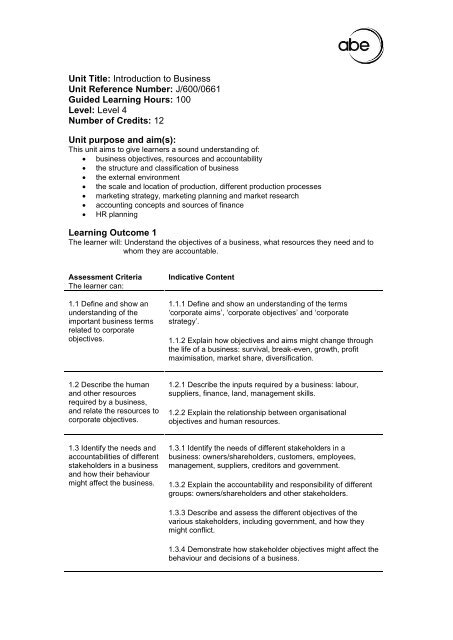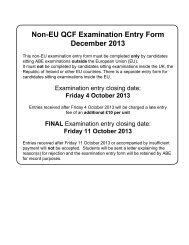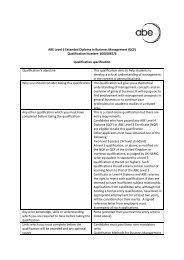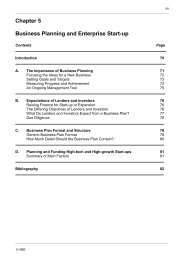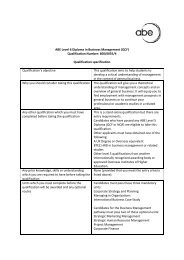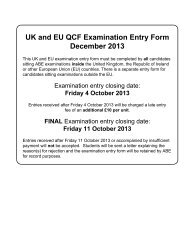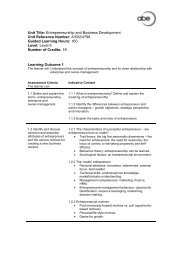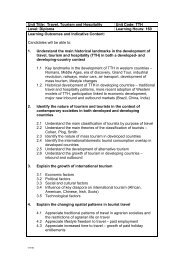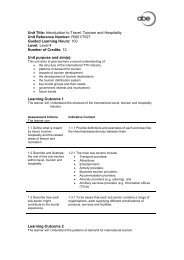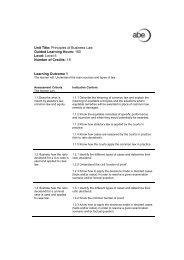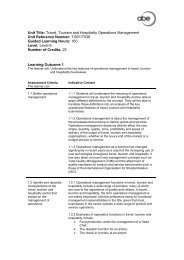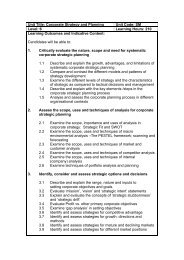Introduction to Business - Association of Business Executives
Introduction to Business - Association of Business Executives
Introduction to Business - Association of Business Executives
Create successful ePaper yourself
Turn your PDF publications into a flip-book with our unique Google optimized e-Paper software.
Unit Title: <strong>Introduction</strong> <strong>to</strong> <strong>Business</strong>Unit Reference Number: J/600/0661Guided Learning Hours: 100Level: Level 4Number <strong>of</strong> Credits: 12Unit purpose and aim(s):This unit aims <strong>to</strong> give learners a sound understanding <strong>of</strong>: business objectives, resources and accountability the structure and classification <strong>of</strong> business the external environment the scale and location <strong>of</strong> production, different production processes marketing strategy, marketing planning and market research accounting concepts and sources <strong>of</strong> finance HR planningLearning Outcome 1The learner will: Understand the objectives <strong>of</strong> a business, what resources they need and <strong>to</strong>whom they are accountable.Assessment CriteriaThe learner can:1.1 Define and show anunderstanding <strong>of</strong> theimportant business termsrelated <strong>to</strong> corporateobjectives.Indicative Content1.1.1 Define and show an understanding <strong>of</strong> the terms‘corporate aims’, ‘corporate objectives’ and ‘corporatestrategy’.1.1.2 Explain how objectives and aims might change throughthe life <strong>of</strong> a business: survival, break-even, growth, pr<strong>of</strong>itmaximisation, market share, diversification.1.2 Describe the humanand other resourcesrequired by a business,and relate the resources <strong>to</strong>corporate objectives.1.2.1 Describe the inputs required by a business: labour,suppliers, finance, land, management skills.1.2.2 Explain the relationship between organisationalobjectives and human resources.1.3 Identify the needs andaccountabilities <strong>of</strong> differentstakeholders in a businessand how their behaviourmight affect the business.1.3.1 Identify the needs <strong>of</strong> different stakeholders in abusiness: owners/shareholders, cus<strong>to</strong>mers, employees,management, suppliers, credi<strong>to</strong>rs and government.1.3.2 Explain the accountability and responsibility <strong>of</strong> differentgroups: owners/shareholders and other stakeholders.1.3.3 Describe and assess the different objectives <strong>of</strong> thevarious stakeholders, including government, and how theymight conflict.1.3.4 Demonstrate how stakeholder objectives might affect thebehaviour and decisions <strong>of</strong> a business.
Learning Outcome 2The learner will: Understand the structure and classification <strong>of</strong> business.Assessment CriteriaThe learner can:2.1 Classify an economyby sec<strong>to</strong>rs.Indicative Content2.1.1 Classify an economy by sec<strong>to</strong>r: primary, secondary,tertiary.2.1.2 Explain the difference between the private sec<strong>to</strong>r and thepublic sec<strong>to</strong>r in terms <strong>of</strong> ownership and objectives.2.2 Describe and evaluatedifferent forms <strong>of</strong> corporatelegal structure.2.2.1 Describe advantages and disadvantages <strong>of</strong> different forms<strong>of</strong> legal structure: sole trader, partnership, franchise, privatelimited company, public limited company.Learning Outcome 3The learner will: Understand how the external environment creates opportunities and threatsfor a business.Assessment CriteriaThe learner can:3.1 Describe the effect onbusinesses <strong>of</strong> changes inexternal fac<strong>to</strong>rs.Indicative Content3.1.1 Describe the effect on businesses <strong>of</strong> changes in externaleconomic fac<strong>to</strong>rs: interest rates, exchange rates, inflation,unemployment, the business cycle, government legislation,technology.3.1.2 Describe other non-economic influences on businessactivity: environmental, cultural, moral and ethical.3.2 Explain how firms canuse PESTEL analysis aspart <strong>of</strong> a business strategy.3.2.1 Explain how firms can use PESTEL (political, economic,social, technological, environmental, legislative influences)analysis as part <strong>of</strong> a business strategy.Learning Outcome 4The learner will: Understand the fac<strong>to</strong>rs that influence the scale <strong>of</strong> production, the location <strong>of</strong>production and the choice between different types <strong>of</strong> production process.
Assessment CriteriaThe learner can:4.1 Explain economies anddiseconomies <strong>of</strong> scale.Indicative Content4.1.1 Explain, and give examples <strong>of</strong>, economies anddiseconomies <strong>of</strong> scale.4.2 Describe the fac<strong>to</strong>rsthat influence the location<strong>of</strong> a business.4.2.1 Describe the fac<strong>to</strong>rs that influence the location <strong>of</strong> abusiness: availability <strong>of</strong> land, labour, closeness <strong>to</strong> market,transport routes, government grants, planning permission andenvironmental fac<strong>to</strong>rs.4.3 Describe and evaluatethe production process.4.3.1 Describe the production process and its associatedadvantages and disadvantages: job, batch, flow, lean and cell.Learning Outcome 5The learner will: Understand the marketing process including marketing strategy, marketingplanning and market research.Assessment CriteriaThe learner can:5.1 Explain the importance<strong>of</strong> the marketing processand define key marketingterms, including marketsegmentation, Product LifeCycle, marketing mix,niche market, massmarket, Unique SellingPoint.Indicative Content5.1.1 Define and explain the importance <strong>of</strong> the marketingprocess.5.1.2 Explain how a market for a product can be segmentede.g. clothes, vehicles, holidays etc.5.1.3 Illustrate with a diagram and describe the Product LifeCycle.5.1.4 Discuss the role <strong>of</strong> the marketing mix (4 P’s) as part <strong>of</strong> amarketing plan.5.1.5 Describe and explain how the marketing mix mightchange at different points <strong>of</strong> the product life cycle.5.1.6 Define other principle marketing terms: niche market,mass market, USP (Unique Selling Point).5.2 Explain marketingstrategy in terms <strong>of</strong>company objectives,available resources andmarket possibilities.5.2.1 Explain marketing strategy in terms <strong>of</strong> companyobjectives, available resources and market possibilities.5.3 Describe alternativemethods <strong>of</strong> marketresearch.5.3.1 Describe alternative methods <strong>of</strong> market research: primaryand secondary.
Learning Outcome 6The learner will: Understand the main accounting concepts and sources <strong>of</strong> finance forbusiness.Assessment CriteriaThe learner can:6.1 Define and explainbasic accounting andbudgeting concepts.Indicative Content6.1.1 Define basic accounting terms: fixed costs, variable costs,revenue, pr<strong>of</strong>it, break-even, working capital. Candidates will beexpected <strong>to</strong> produce numerical calculations <strong>to</strong> demonstrate theirunderstanding <strong>of</strong> the above terms.6.1.2 Define and describe the purpose <strong>of</strong> budgets and cash flowforecasts; advantages and disadvantages.6.2 Describe and evaluatedifferent sources <strong>of</strong> financefor business.6.2.1 Describe short term, medium term and long term sources<strong>of</strong> finance.6.2.2 Determine the appropriate source <strong>of</strong> finance <strong>to</strong> match abusiness need e.g. overdraft for temporary expansion <strong>of</strong> s<strong>to</strong>cklevels.6.2.3 Explain the relative benefits and disadvantages <strong>of</strong> eachtype <strong>of</strong> finance.Learning Outcome 7The learner will: Understand the need for human resource planning, and the importance <strong>of</strong>motivation in theory and in practice.Assessment CriteriaThe learner can:7.1 Describe workforceplanning in action andcalculate labour turnover fora business.Indicative Content7.1.1 Describe workforce planning in action and evaluatedifferent approaches <strong>to</strong> recruitment, selection, induction andtraining.7.1.2 Define and give equation for labour turnover.7.2 Explain and evaluate theprincipal motivation theoriesand different practicalapproaches <strong>to</strong> motivation,including the use <strong>of</strong>remuneration as a motiva<strong>to</strong>r.7.2.1 Explain the principal theories: Taylor, Mayo, Maslowand Herzberg.7.2.2 Describe and give the benefits <strong>of</strong> motivation in practice:job enrichment, job enlargement, empowerment, teamworking.
7.2.3 Comment upon the benefits and disadvantages <strong>of</strong>different means <strong>of</strong> remuneration: piecework, time-basedwage, salary, commission, pr<strong>of</strong>it sharing, share ownership,fringe benefits.Assessment: Assessment method: written examination (unless otherwise stated). Written examinations are <strong>of</strong> three hours’ duration. All learning outcomes will be assessed.Recommended Reading: <strong>Introduction</strong> <strong>to</strong> <strong>Business</strong> – ABE Study Manual. Please refer <strong>to</strong> the Tuition Resources section <strong>of</strong> the Members Area <strong>of</strong> the ABEwebsite (www.abeuk.com) for further recommended reading.


